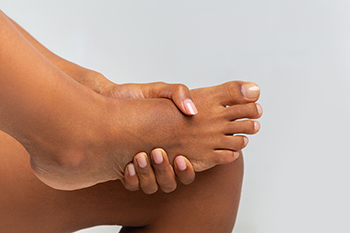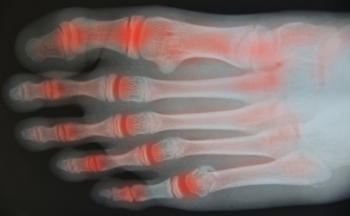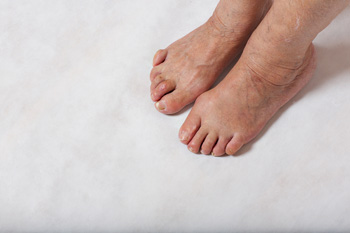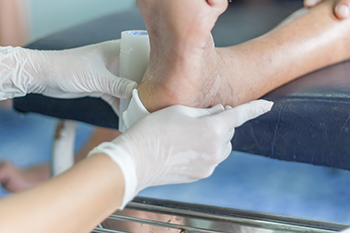Connect With Us
Blog
Items filtered by date: March 2022
Gout Pain Can Be Managed
Elderly People and Poor Circulation
 It is common for elderly people to undergo changes in their circulatory system. This can be a normal part of the aging process as a result of strain on the veins and arteries. Some of the symptoms that are associated with poor circulation include a tingling sensation, pain, and muscle cramps. Additionally, the feet may turn blue or purple, the toenails can become weak, and there can be hair loss on the legs. Mild relief can be found by massaging the feet, staying active, and it can help to refrain from drinking caffeine and alcohol. Poor circulation may be a symptom of an underlying condition. If you have signs of this ailment, it is strongly suggested that you speak with a podiatrist as quickly as possible who can properly assess and treat your circulation issues.
It is common for elderly people to undergo changes in their circulatory system. This can be a normal part of the aging process as a result of strain on the veins and arteries. Some of the symptoms that are associated with poor circulation include a tingling sensation, pain, and muscle cramps. Additionally, the feet may turn blue or purple, the toenails can become weak, and there can be hair loss on the legs. Mild relief can be found by massaging the feet, staying active, and it can help to refrain from drinking caffeine and alcohol. Poor circulation may be a symptom of an underlying condition. If you have signs of this ailment, it is strongly suggested that you speak with a podiatrist as quickly as possible who can properly assess and treat your circulation issues.
Poor circulation is a serious condition and needs immediate medical attention. If you have any concerns with poor circulation in your feet contact Mark Isenberg, DPM of Center for Podiatric Excellence. Our doctor will treat your foot and ankle needs.
Poor Circulation in the Feet
Poor blood circulation in the feet and legs is can be caused by peripheral artery disease (PAD), which is the result of a buildup of plaque in the arteries.
Plaque buildup or atherosclerosis results from excess calcium and cholesterol in the bloodstream. This can restrict the amount of blood which can flow through the arteries. Poor blood circulation in the feet and legs are sometimes caused by inflammation in the blood vessels, known as vasculitis.
Causes
Lack of oxygen and oxygen from poor blood circulation restricts muscle growth and development. It can also cause:
- Muscle pain, stiffness, or weakness
- Numbness or cramping in the legs
- Skin discoloration
- Slower nail & hair growth
- Erectile dysfunction
Those who have diabetes or smoke are at greatest risk for poor circulation, as are those who are over 50. If you have poor circulation in the feet and legs it may be caused by PAD and is important to make changes to your lifestyle in order to reduce risk of getting a heart attack or stroke. Exercise and maintaining a healthy lifestyle will dramatically improve conditions.
As always, see a podiatrist as he or she will assist in finding a regimen that suits you. A podiatrist can also prescribe you any needed medication.
If you have any questions please feel free to contact our office located in Pensacola, FL . We offer the newest diagnostic and treatment technologies for all your foot and ankle needs.
Causes of Metatarsal Pain in the Ball of the Foot
 When you feel pain in the ball of the foot it could be a sign of metatarsalgia. This condition can have several causes, some more simple to correct than others. For instance, in some cases just changing your footwear from high-heeled shoes to flatter heels, therefore reducing the pressure on the ball of the foot, can help. Many runners develop metatarsalgia from overuse, caused by running longer distances more often. Sports that involve jumping may also bring about this injury. Being overweight, having a hammertoe or bunion that affects your gait, or having stiffness in the ankle or Achilles tendon, can also cause more stress on the metatarsal bones. The pain generated by metatarsalgia usually starts gradually and gets worse the more you stand, walk, run, or further aggravate the foot. A podiatrist can examine your foot with X-rays or other imaging tests, make a proper diagnosis, and suggest treatment options depending on the underlying cause and the severity of the pain. If you are struggling with pain in the ball of your foot it is suggested that you schedule an appointment with your local podiatrist.
When you feel pain in the ball of the foot it could be a sign of metatarsalgia. This condition can have several causes, some more simple to correct than others. For instance, in some cases just changing your footwear from high-heeled shoes to flatter heels, therefore reducing the pressure on the ball of the foot, can help. Many runners develop metatarsalgia from overuse, caused by running longer distances more often. Sports that involve jumping may also bring about this injury. Being overweight, having a hammertoe or bunion that affects your gait, or having stiffness in the ankle or Achilles tendon, can also cause more stress on the metatarsal bones. The pain generated by metatarsalgia usually starts gradually and gets worse the more you stand, walk, run, or further aggravate the foot. A podiatrist can examine your foot with X-rays or other imaging tests, make a proper diagnosis, and suggest treatment options depending on the underlying cause and the severity of the pain. If you are struggling with pain in the ball of your foot it is suggested that you schedule an appointment with your local podiatrist.
Foot Pain
Foot pain can be extremely painful and debilitating. If you have a foot pain, consult with Mark Isenberg, DPM from Center for Podiatric Excellence. Our doctor will assess your condition and provide you with quality foot and ankle treatment.
Causes
Foot pain is a very broad condition that could be caused by one or more ailments. The most common include:
- Bunions
- Hammertoes
- Plantar Fasciitis
- Bone Spurs
- Corns
- Tarsal Tunnel Syndrome
- Ingrown Toenails
- Arthritis (such as Gout, Rheumatoid, and Osteoarthritis)
- Flat Feet
- Injury (from stress fractures, broken toe, foot, ankle, Achilles tendon ruptures, and sprains)
- And more
Diagnosis
To figure out the cause of foot pain, podiatrists utilize several different methods. This can range from simple visual inspections and sensation tests to X-rays and MRI scans. Prior medical history, family medical history, and any recent physical traumatic events will all be taken into consideration for a proper diagnosis.
Treatment
Treatment depends upon the cause of the foot pain. Whether it is resting, staying off the foot, or having surgery; podiatrists have a number of treatment options available for foot pain.
If you have any questions, please feel free to contact our office located in Pensacola, FL . We offer the newest diagnostic and treatment technologies for all your foot care needs.
Arthritis in the Big Toe
 If you feel pain in the joint of your big toe, especially while you are active, it could be “big toe arthritis” or Hallux rigidus. This arthritic condition typically impacts people over age 50, is more apt to affect women, and is the most common arthritic condition of the foot. The hallux metarsal-phalangeal (MTP) joint connects the head of the first forefoot bone to the base of the first toe bone and to two tiny bones under that joint. Signs of this problem are swelling of this joint and limited movement and bending of the big toe. A bump, like a bunion or bone spur, can develop on the top of this toe joint, which can get further aggravated by rubbing against the inside of a shoe. Causes for this condition are not known, however prior injury to the big toe, differences in foot anatomy, and genetics can play a role in its development. Treatments can range from being prescribed a rigid orthotic to a cortisone shot, and as a last resort, surgery. A podiatrist can properly diagnose and offer alternative treatments to lessen the pain associated with Hallux rigidus.
If you feel pain in the joint of your big toe, especially while you are active, it could be “big toe arthritis” or Hallux rigidus. This arthritic condition typically impacts people over age 50, is more apt to affect women, and is the most common arthritic condition of the foot. The hallux metarsal-phalangeal (MTP) joint connects the head of the first forefoot bone to the base of the first toe bone and to two tiny bones under that joint. Signs of this problem are swelling of this joint and limited movement and bending of the big toe. A bump, like a bunion or bone spur, can develop on the top of this toe joint, which can get further aggravated by rubbing against the inside of a shoe. Causes for this condition are not known, however prior injury to the big toe, differences in foot anatomy, and genetics can play a role in its development. Treatments can range from being prescribed a rigid orthotic to a cortisone shot, and as a last resort, surgery. A podiatrist can properly diagnose and offer alternative treatments to lessen the pain associated with Hallux rigidus.
Arthritis can be a difficult condition to live with. If you are seeking treatment, contact Mark Isenberg, DPM from Center for Podiatric Excellence. Our doctor can provide the care you need to keep you pain-free and on your feet.
Arthritic Foot Care
Arthritis is a joint disorder that involves the inflammation of different joints in your body, such as those in your feet. Arthritis is often caused by a degenerative joint disease and causes mild to severe pain in all affected areas. In addition to this, swelling and stiffness in the affected joints can also be a common symptom of arthritis.
In many cases, wearing ill-fitting shoes can worsen the effects and pain of arthritis. Wearing shoes that have a lower heel and extra room can help your feet feel more comfortable. In cases of rheumatoid arthritis, the arch in your foot may become problematic. Buying shoes with proper arch support that contour to your feet can help immensely.
Alleviating Arthritic Pain
- Exercises that stretch the foot can prevent further pain and injury and increase mobility
- Most of the pain can be alleviated with anti-inflammatory drugs, heat, and topical medications
- Massages can help temporarily alleviate pain.
It is best to see your doctor for the treatment that is right for your needs and symptoms. Conditions vary, and a podiatrist can help you determine the right method of care for your feet.
If you have any questions, please feel free to contact our office located in Pensacola, FL . We offer the newest diagnostic tools and technology to treat your foot and ankle needs.
What Is a Hammertoe?
A hammertoe is when a toe joint (usually the second or middle toe joint) points up instead of lying flat and causes the toe to look like a hammer. This condition can be painful and can lead to difficulty walking. The affected joint often gets rigid, the joint stiffens, sometimes to non-movement. Sometimes a corn or callus may develop on the joint and can cause pain and swelling on the top of the bent toe. This affliction can be caused by weak foot or leg muscles which lead to the tendon pulling up the toe in an abnormal position. Hammertoes are more apt to happen to those who wear high heels or shoes that do not properly support the feet. However, foot type at birth, those with neuromuscular disease, and trauma may predispose one to develop this joint deformity as well. If you think you have symptoms of a hammertoe, it is recommended that you see a qualified podiatrist as soon as possible for proper diagnosis and treatment.
Hammertoe
Hammertoes can be a painful condition to live with. For more information, contact Mark Isenberg, DPM from Center for Podiatric Excellence. Our doctor will answer any of your foot- and ankle-related questions.
Hammertoe is a foot deformity that affects the joints of the second, third, fourth, or fifth toes of your feet. It is a painful foot condition in which these toes curl and arch up, which can often lead to pain when wearing footwear.
Symptoms
- Pain in the affected toes
- Development of corns or calluses due to friction
- Inflammation
- Redness
- Contracture of the toes
Causes
Genetics – People who are genetically predisposed to hammertoe are often more susceptible
Arthritis – Because arthritis affects the joints in your toes, further deformities stemming from arthritis can occur
Trauma – Direct trauma to the toes could potentially lead to hammertoe
Ill-fitting shoes – Undue pressure on the front of the toes from ill-fitting shoes can potentially lead to the development of hammertoe
Treatment
Orthotics – Custom made inserts can be used to help relieve pressure placed on the toes and therefore relieve some of the pain associated with it
Medications – Oral medications such as anti-inflammatories or NSAIDs could be used to treat the pain and inflammation hammertoes causes. Injections of corticosteroids are also sometimes used
Surgery – In more severe cases where the hammertoes have become more rigid, foot surgery is a potential option
If you have any questions please contact our office located in Pensacola, FL . We offer the newest diagnostic and treatment technologies for all your foot and ankle needs.
Blue or Purple Feet Can Be a Sign of Trouble
If you drop something on your foot, it will likely turn purple or blue from bruising. This is normal, and the common solutions of rest, ice, elevation, and compression should help ease the pain as your foot heals. However, chronic discoloration of the feet can be a sign of restricted blood flow brought on by other conditions. Among them are diabetic neuropathy, peripheral artery disease (PAD), lupus, or Raynaud’s disease. In some way all of these conditions limit the flow of blood to the extremities and can cause foot swelling, discoloration and numbness. If you notice that your feet have changed color for longer periods, it may be wise to consult a podiatrist who can offer a complete examination and diagnosis of your feet and recommend the best treatment options for you.
Everyday foot care is very important to prevent infection and other foot ailments. If you need your feet checked, contact Mark Isenberg, DPM from Center for Podiatric Excellence. Our doctor can provide the care you need to keep you pain-free and on your feet.
Everyday Foot Care
Often, people take care of their bodies, face and hair more so than they do for their feet. But the feet are a very important aspect of our bodies, and one that we should pay more attention to. Without our feet, we would not be able to perform most daily tasks.
It is best to check your feet regularly to make sure there are no new bruises or cuts that you may not have noticed before. For dry feet, moisturizer can easily be a remedy and can be applied as often as necessary to the affected areas. Wearing shoes that fit well can also help you maintain good foot health, as well as making it easier to walk and do daily activities without the stress or pain of ill-fitting shoes, high heels, or even flip flops. Wearing clean socks with closed shoes is important to ensure that sweat and bacteria do not accumulate within the shoe. Clean socks help to prevent Athlete’s foot, fungi problems, bad odors, and can absorb sweat.
If you have any questions please feel free to contact our office located in Pensacola, FL . We offer the newest diagnostic and treatment technologies for all your foot and ankle needs.
Blog Archives
- April 2025
- March 2025
- February 2025
- January 2025
- December 2024
- November 2024
- October 2024
- September 2024
- August 2024
- July 2024
- June 2024
- May 2024
- April 2024
- March 2024
- February 2024
- January 2024
- December 2023
- November 2023
- October 2023
- September 2023
- August 2023
- July 2023
- June 2023
- May 2023
- April 2023
- March 2023
- February 2023
- January 2023
- December 2022
- November 2022
- October 2022
- September 2022
- August 2022
- July 2022
- June 2022
- May 2022
- April 2022
- March 2022
- February 2022
- January 2022
- December 2021
- November 2021
- October 2021
- September 2021
- August 2021
- July 2021
- June 2021
- May 2021
- April 2021
- March 2021
- February 2021



